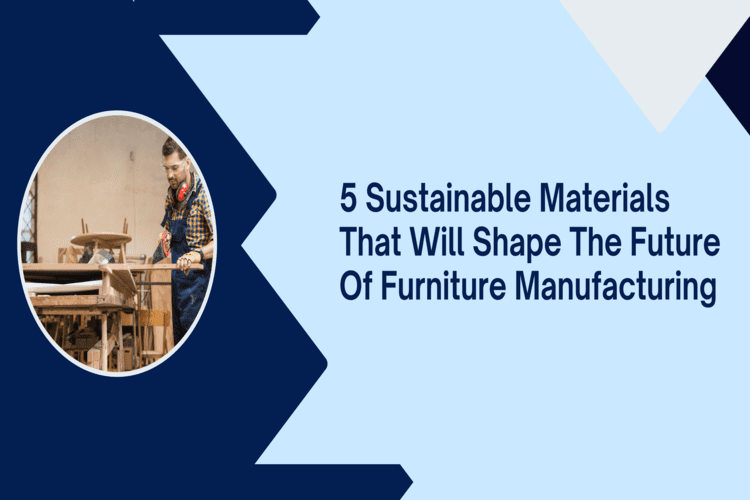
5 Sustainable Materials That Will Shape the Future of Furniture Manufacturing
The word “sustainability” has recently become popular in the field of Furniture Manufacturing, and with good reason. As people become more concerned about issues such as climate change and the degradation of the environment, businesses that manufacture furniture are increasingly looking to sustainable materials and manufacturing practices in order to lessen the impact that they have on the earth, with the help of Furniture Repair and Restoration too. In this article, we will discuss 5 Eco-Friendly Materials Revolutionizing Furniture Production that are redefining the future of the furniture business and pushing it into a more environmentally conscious era.
1.Bamboo
In recent years, bamboo has emerged as a popular option for use in the production of furniture due to its rapid growth and inherent regenerative properties. Because it is a material that is naturally resistant to dampness and insects in addition to being long-lasting and lightweight, it is an excellent option for the construction of outdoor furniture as well as office furniture. Additionally, bamboo is a flexible material that can be used in a range of furniture designs, ranging from contemporary to rustic.
In addition to the favourable effects it has on the environment, bamboo also has positive consequences for the society in which it is grown. It is customary for it to be cultivated in third-world countries since it gives employment chances to the local communities, which is one reason why it is planted there.
2.Cork
Cork is another renewable material that is gaining popularity in the furniture industry. It is harvested from the bark of cork oak trees, which can be harvested without harming the tree itself. Cork is a lightweight, durable, and versatile material that is often used in the manufacturing of furniture, particularly for seating and tabletops.
Because cork is a natural insulator, putting it to use in buildings like houses and businesses can help keep the temperature more stable and reduce the amount of money spent on heating and cooling the space. So you can call it house furniture. Not only is cork good for the environment, but it is also a material that can be recycled and naturally breaks down over time.
3.Recycled Plastic
Recycled plastic is a material that is becoming increasingly popular in the furniture industry. It is made from post-consumer plastic waste, such as water bottles and packaging materials. By using recycled plastic, furniture companies can reduce their reliance on virgin plastic, which is a non-renewable resource that contributes to environmental pollution.
Plastic that has been recycled is an exceptionally durable and water-resistant material that can be repurposed into a wide variety of furniture designs, including outdoor chairs and indoor tables, due to the fact that it can be moulded into virtually any shape. In addition to this, it is a material that requires little maintenance due to the fact that it is easy to clean and does not have to be painted or stained.
4. Reclaimed Wood
Reclaimed wood is another sustainable material that is gaining popularity in the furniture industry. It is wood that has been salvaged from old buildings, barns, and other structures that are no longer in use. By using reclaimed wood, furniture companies can reduce the demand for new wood and preserve natural resources. This comes under the category of sustainable furniture.
The rustic and one-of-a-kind appearance of reclaimed wood makes it a popular choice for a wide variety of furniture types, from industrial to farmhouse. It is also a material that is long-lasting and can sustain wear and tear over the course of time.
5. Mycelium
Mycelium is a material that is formed from the root structure of mushrooms and is considered to be environmentally friendly, promoting Sustainability The production of furniture is just one of many uses for this versatile and environmentally friendly material, which can also be composted after its useful life has ended.
Mycelium can be grown in moulds to create custom shapes and forms for furniture pieces. It is also a lightweight and strong material that can be used in a variety of furniture styles, from chairs to tables.
Mycelium is beneficial for the environment, but it also has other advantages, such as the ability to absorb and filter airborne contaminants, as well as fire-resistance and other features that make it resistant to fire.
B2C and B2B enterprises in the furniture sector can work together to advance sustainability as well as other goals. For instance, B2C companies can offer insightful information on consumer trends and preferences, which can assist B2B companies in creating more specialised marketing plans and product designs. B2B companies can enhance their services and maintain market competitiveness by using B2C firms’ comments on the quality, usability, and design of furniture products. Additionally, furniture stores email list can be acquired for marketing purposes by B2B marketers for promoting their business in the furniture industry too.
In conclusion, the furniture business is fast developing toward a more sustainable future, and these five materials are leading the way in this evolution. It is possible for enterprises that make furniture to lessen their negative impact on the environment and work toward creating a more sustainable future if they use the following materials and production methods: As customers, we can also do our part by opting for furniture that is crafted from eco-friendly materials and lending our support to businesses that place an emphasis on responsible environmental management. If we work together, we will be able to make a better future not only for ourselves but also for the entire planet.


